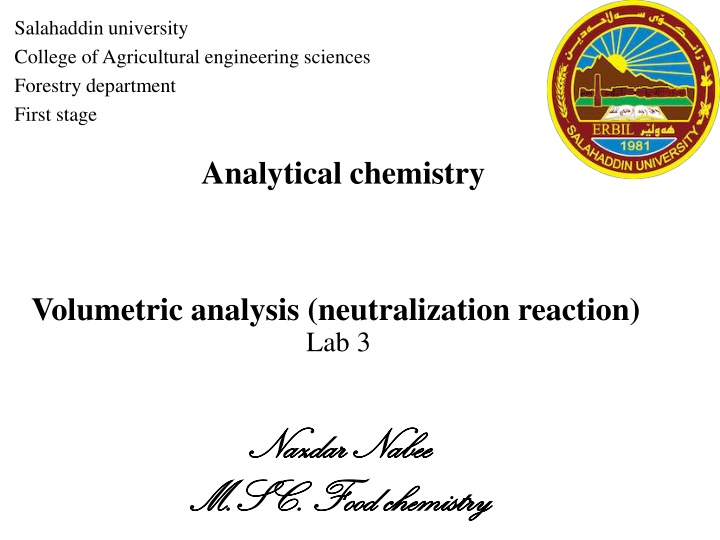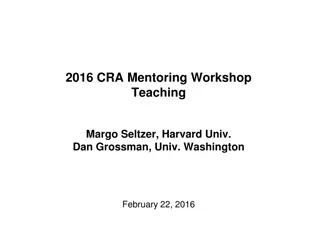
Volumetric Analysis in Analytical Chemistry
Learn about volumetric analysis, a method in quantitative chemical analysis to determine the amount of a substance based on volume measurement. Discover titration, the process of reacting an analyte with a titrant to determine concentration, and how indicators help in marking the end point accurately.
Download Presentation

Please find below an Image/Link to download the presentation.
The content on the website is provided AS IS for your information and personal use only. It may not be sold, licensed, or shared on other websites without obtaining consent from the author. If you encounter any issues during the download, it is possible that the publisher has removed the file from their server.
You are allowed to download the files provided on this website for personal or commercial use, subject to the condition that they are used lawfully. All files are the property of their respective owners.
The content on the website is provided AS IS for your information and personal use only. It may not be sold, licensed, or shared on other websites without obtaining consent from the author.
E N D
Presentation Transcript
Salahaddin university College of Agricultural engineering sciences Forestry department First stage Analytical chemistry Volumetric analysis (neutralization reaction) Lab 3 Nazdar Nazdar Nabee M.SC M.SC. Food chemistry . Food chemistry Nabee
Volumetric analysis It is a general term for a method in quantitative chemical analysis in which the amount of a substance is determined by the measurement of the volume that the substance occupies. It is commonly used to determine the unknown concentration of a known reactant. Volumetric analysis is often referred to as titration.
Titration Titration is an analytical technique which allows the quantitative determination of a specific substance (analyte) dissolved in a sample. It is based on a complete chemical reaction between the analyte and a reagent (titrant) of known concentration (a standard solution) which is added to the sample. And volume is used to react with a measured quantity of reactant (analyte).
The analyte is the solution with an unknown molarity. The reagent (titrant) is the solution with a known molarity that will react with the analyte. aA + bB products where : A = titrant B = titrate (analyte) a,b = no. of moles
Titrant Analyte
The object of the titration is the detection of the equivalence point,the point in which the amount of standard solution is chemically equivalent to the substance that is to be determined. or the amount of added titrant is chemically equivalent to the amount of analyte in the sample.
There for at the equivalence point: moles of titrant = moles of analyte Rearranging the molarity equation shows that molarity x volume (in liters) = moles of solute. M x V (titrant) = M x V (analyte)
Indicator: is an organic substance that have one colour in acid solution and another in basic solution. The indicator is one that will change in colour when acid has reacted with all of the base present. The point in the titration at which the color change occurs is called the end point.Obviously, the titration will be accurate only if the end point and the equivalence point coincide fairly closely.
End point: is based upon the physical changes that occur in a solution in titration method. The end point detection including change in color, Best titration, when that the volume difference between end point and equivalent point is small. (When the end point is exactly same the equivalent point).
Standard solution: Is a solution with accurately known concentration. A primary standard compounds should have these requirements: 1. It should be 100% pure. 2. It should be stable to drying temperature, light and air. 3. It should be readily available and low cost.
Types of titration reactions: 1- Neutralization reaction ion (acid- base titration):Chemical reaction where an acid and base react to form a salt. CH3COOH + NaOH CH3COONa + H2O 2- Precipitation reaction: Are based upon reactions that yield ionic compound of limited solubility. Ag+aq + Cl- aq AgCl (precipitate) 3- Oxidation- Reduction reaction: Is defined as any reaction in which electrons are transferred from one substance to another 3 Fe2+ + Cr6+ 3 Fe3+ + Cr3+ 4- Complexometric reaction: Depend on the formation of a complex between the analyte and the titrant. EDTA2- + Ca2+ EDTA-Ca complex
1-Acid- Base Titration (neutralization reaction) An acid base titration is a method of quantitative analysis for determining the concentration of an acid or base by exactly neutralizing it with a standard solution of base or acid having known concentration. It is considered specifically an acid-base titration because an acid-base reaction is occurring between the titrant and analyte. NaOH + HCl NaCl + H2O
Procedure: 1. Fill the burette with the prepared 0.1 N NaOH solution. 2. Add 10 ml of the Hcl solution into a clean conical flask. 3. Add 2-3 drops of phenolphthalein (ph-ph) as an indicator to the conical flask. 4. Add drop wise of NaOH to the Hcl solution until the solution turns to the pink color that remains for 30 seconds. This is called your endpoint.
Calculation N1V1 = N2V2 HCl NaOH ? * 10 = 0.1 * From burette N1= Normality of HCl






















